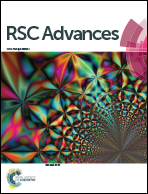Young's modulus and Poisson's ratio for TiO2-based nanotubes and nanowires: modelling of temperature dependence
Abstract
In this work molecular mechanics simulations with the help of interatomic potentials were employed to predict the temperature dependence of the Young's modulus and Poisson's ratio of a number of TiO2-based four-facetted nanotubes and nanowires. The temperature dependence of the Young's modulus was obtained through the calculation of the Helmholtz free energy of the system under isothermal thermodynamic conditions. The Helmholtz free energy simulations were performed in the framework of quasi-harmonic approximation as a result of calculations of the potential energy and the harmonic phonon frequencies of the system under consideration. The Helmholtz free energy calculated for the set of fixed values of the nanoobject translational period allows obtaining the minimal Helmholtz free energy at specified temperatures in the range 0–1000 K. The present simulations demonstrate that the Young's modulus for the TiO2-based nanowires decreases with the increase of the nanowire diameters, and approaches the modulus for the rutile bulk crystal from above. Also, the temperature behavior of the Young's modulus, Poisson's ratio and period for the nanotubes and nanowires are considered. This study reveals that the Poisson's ratios of the nanotubes and nanowires depend on the surface atoms chosen to measure the transverse dimensions of the nanostructures.


 Please wait while we load your content...
Please wait while we load your content...